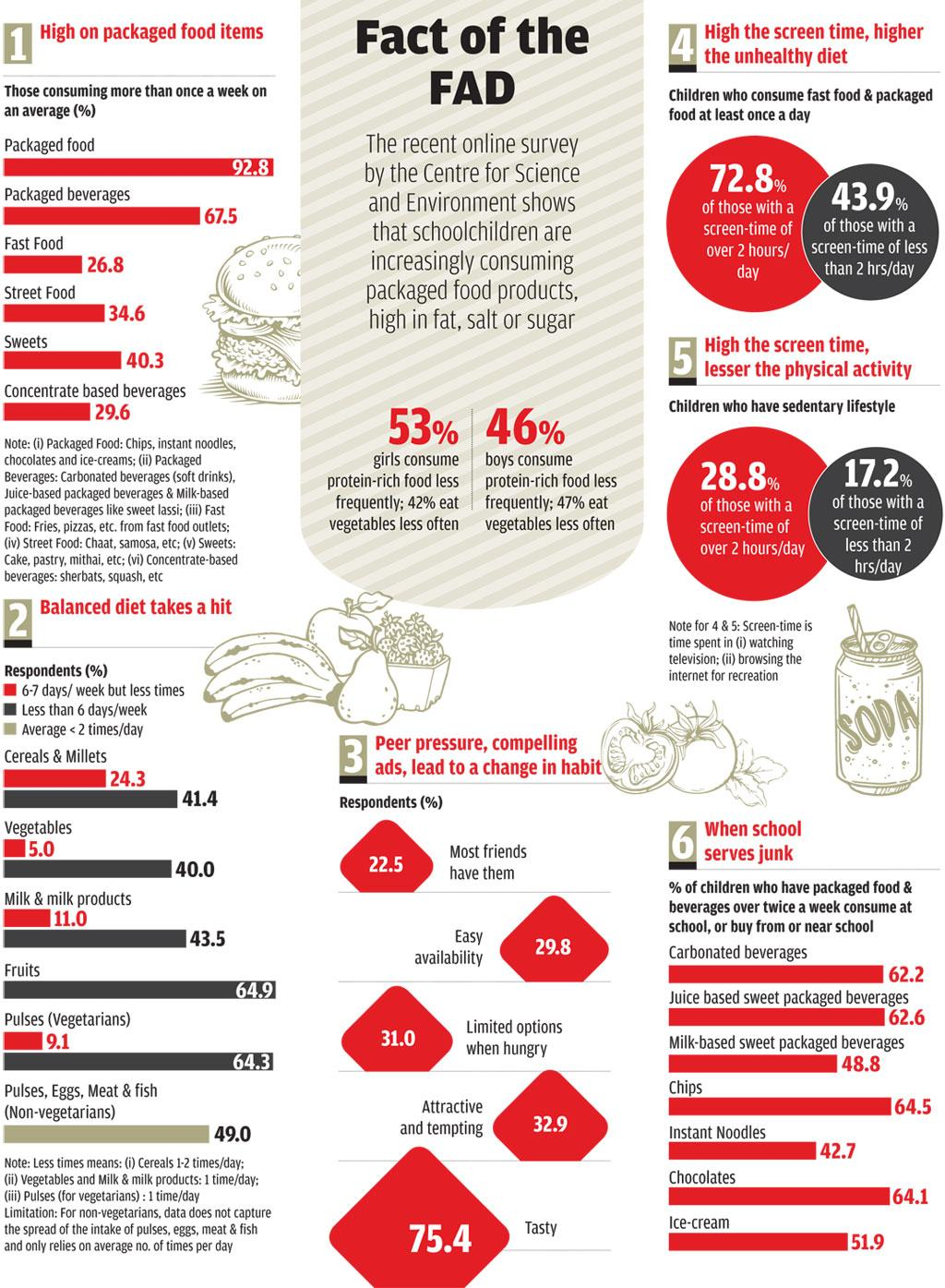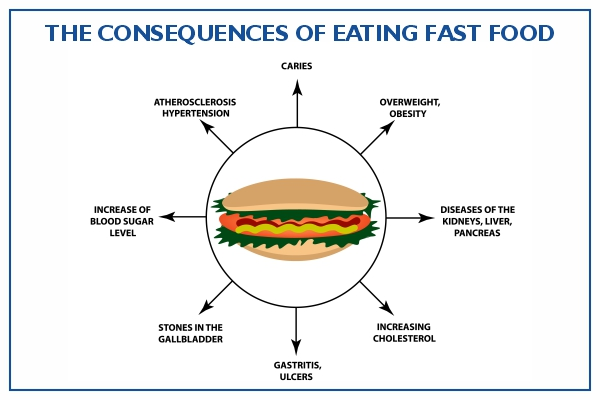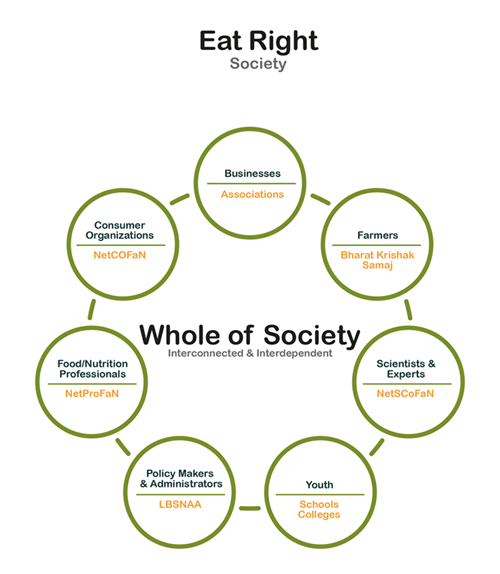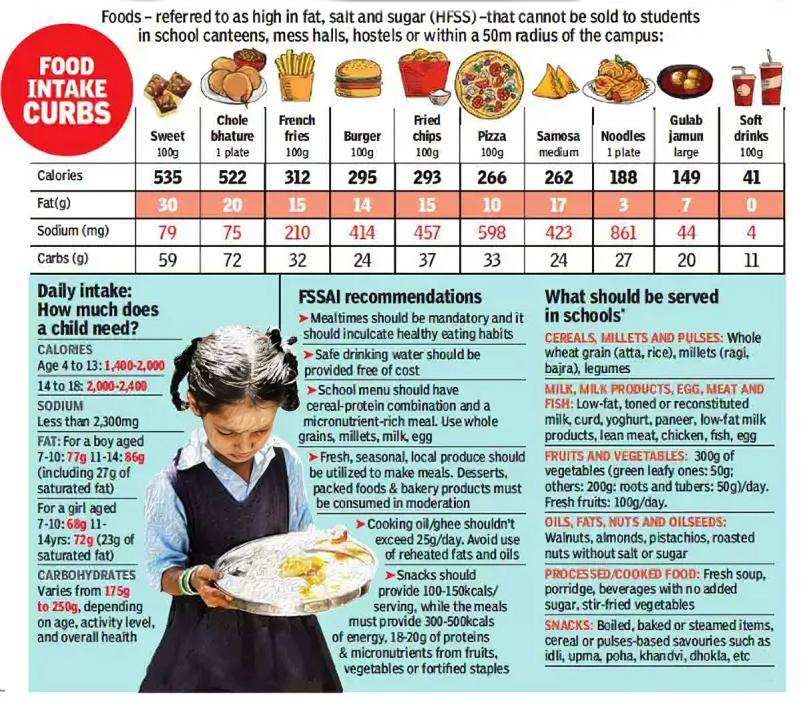Agriculture
Curbing Intake of Processed Foods
This editorial is based on “Toss out the junk food, bring back the healthy food plate” which was published in The Hindu on 24/04/2024. The article addresses the concerns raised by the consumption of junk food and emphasizes the necessity for a grassroots movement supported by genuine policy measures to encourage healthy and nutritionally varied diets, as well as to ensure informed food decisions.
For Prelims: Ultra-Processed Food, Food Processing Industry, Food Safety and Standards Authority of India (FSSAI), High Fat Sugar Salt (HFSS) Foods, ‘Eat Right Station’ Certification, Food Safety, National Health Policy 2017, Ayushman Bharat, POSHAN Abhiyaan, Anaemia Mukt Bharat.
For Mains: Food Processing Industry, Concerns Over Consuming Ultra-Processed and High Fat Sugar Salt (HFSS) Foods.
India, like many other countries, is undergoing a major “nutrition transition”. In what characterises rapidly changing dietary patterns, there is a significant shift away from traditional diets, which were high in fibre and comprised mostly whole foods, to more western-style diets, which are processed and high in calories. This change has coincided with rapid economic progress and urbanisation along with a surge in the consumption of packaged and processed foods (popularly called “junk foods”).
Junk foods are foods that are high in calories, sugars, unhealthy fats, and salt but low in nutrients. These foods are often highly processed and are typically low in fiber, vitamins, and minerals. Examples of junk foods include fast food items like burgers, fries, and pizzas, sugary snacks like cookies, candies, and sodas, and salty snacks like chips and pretzels. Consuming junk food regularly can lead to various health problems, including obesity, heart disease, type 2 diabetes, and dental issues. These foods are often convenient and appealing but offer little nutritional value.
What are the Various Concerns Related to Junk (Fast) Foods in India?
- Categorised as HFSS Foods:
- Categorised as high in fats, salts and sugars (HFSS) foods, scientific evidence shows how junk food has been medically found to weaken the body’s defences against infection, increase blood pressure, lead to a spike in blood sugar, cause weight gain, and also contribute to increased risk of cancer.
- Often packaged as comfort foods in India, examples of such junk or HFSS foods include cookies, cakes, chips, namkeen, instant noodles, sugary drinks, frozen meals, canned fruits, Indian sweets, and bakery product.
- Categorised as high in fats, salts and sugars (HFSS) foods, scientific evidence shows how junk food has been medically found to weaken the body’s defences against infection, increase blood pressure, lead to a spike in blood sugar, cause weight gain, and also contribute to increased risk of cancer.
- Significant Rise in Lifestyle Diseases:
- It should come as no surprise that India is experiencing an explosion of lifestyle diseases, with unhealthy diets being one of the single largest contributing factors.
- To put the magnitude of the health burden into perspective, an Indian Council of Medical Research (ICMR) study published in 2023 estimates that in India the prevalence of metabolic disorders is glaringly high where 11% have diabetes, 35% are hypertensive and almost 40% are suffering from abdominal obesity.
- Effects of Aggressive Advertising:
- A significant factor to consider while analysing the evolving dietary habits of Indians is the influence of aggressive advertising to promote “tasty” and “affordable” comfort foods, particularly aimed at younger consumers.
- According to a pan India survey conducted by the Centre for Science and Environment (CSE), 93% of children ate food that was packaged, 68% drank packaged sweetened beverages more than once a week, and 53% ate these foods at least once a day.
- At the same time, the ultra-processed food industry in India has expanded at a compound annual growth rate of 13.37% between 2011 and 2021. Moreover, India’s food processing industry is predicted to be worth USD 535 billion by 2025-26.
- A significant factor to consider while analysing the evolving dietary habits of Indians is the influence of aggressive advertising to promote “tasty” and “affordable” comfort foods, particularly aimed at younger consumers.
- High Glycemic Index (GI) and Glycemic Load:
- There is a lot of evidence to support the growing importance of the GI and GL of diets. The link between high GI and GL diets to the risk of type 2 diabetes has been established recently. However, what is less known is the association of high GI diets with cardiovascular disease and mortality.
- Diets with high GI include sugar and sweets, white rice, maida, potato, white bread, sweetened drinks, jaggery and cookies. This is particularly relevant to India and South Asia where carbohydrate consumption in the form of high GI white rice or wheat, forms the bulk of calories, leading to very high GL of our diets.
- There is a lot of evidence to support the growing importance of the GI and GL of diets. The link between high GI and GL diets to the risk of type 2 diabetes has been established recently. However, what is less known is the association of high GI diets with cardiovascular disease and mortality.
Note:
Glycemic Index (GI) and Glycemic Load (GL):
- The concept of ‘Glycemic Index’ was first proposed by Prof. David Jenkins of the University of Toronto in 1981. The glycemic index (GI) of a food refers to the property of the food to increase the blood glucose level and is a measure of the ‘quality’ of carbohydrates.
- Glucose or white bread is used as the comparator. The GI of glucose is taken as 100 and the GI of other foods is given as a percentage of this.
- Thus, the GI of foods is classified as low GI (less than 55), medium GI (56- 69) and high GI (over 70). The GI multiplied by the amount of the carbohydrate consumed,determines the glycemic load (GL).
Regulating Sugar Content:
- In its Food Safety and Standards (Advertising and Claims) Regulations 2018, the FSSAI said that only if total sugar is less than 5g per 100g in a product, it can claim to be ‘low on sugar.’ World Health Organization’s has set a threshold of consuming 25 grams or six teaspoons of sugar per day.
- The Process of ‘Malting’ in Making the Processed Foods:
- Apart from added sugar, the process of malting, which involves germinating cereals, drying, roasting and powdering them, also produces sugar. Malting was a process originally used to produce single malt whiskey, and is also used in making malt-based milk beverages. Apart from added sugar, the various chocolate powders contains maltodextrin, liquid glucose, maltose generated from malting process of cereals and so on.
- Concerns Due to ‘Processed Baby Foods’:
- For a one to two year old child, the companies such as Nestle recommend feeding twelve scoops or 100 grams of baby food (such as Cerelac) every day. This means the baby consumes 24 grams of sugar each day. Extra sugar in a young baby’s diet creates unnecessary pressure on the baby’s pancreas, leading to production of excess insulin which may lead to diabetes and obesity in future.
- Addition of ingredients like maltodextrin to improve flavour and texture is harmful as the white starchy powder of maltodextrin has a higher glycemic index (GI) than table sugar. Excess sugar gets converted into triglycerides, a form of fat which gets stored in liver leading to fatty liver and insulin resistance that causes diabetes.
- For a one to two year old child, the companies such as Nestle recommend feeding twelve scoops or 100 grams of baby food (such as Cerelac) every day. This means the baby consumes 24 grams of sugar each day. Extra sugar in a young baby’s diet creates unnecessary pressure on the baby’s pancreas, leading to production of excess insulin which may lead to diabetes and obesity in future.
- Lack of Precise Definition for HFSS Foods:
- The Food Safety and Standards Authority of India (FSSAI) has issued regulations to limit the consumption of foods high in fat, sugar, and salt (HFSS). However, there is currently no clear method to define or identify which foods specifically fall into the category of HFSS foods. This lack of a precise definition or identification process poses a challenge in effectively regulating the consumption of these unhealthy foods.
- FSSAI Using Rating Stars and Not Warning Labels:
- In September 2022, the FSSAI put out a draft notification which was released to explain what a HFSS food would consist of and how to warn consumers against it on front-of-the-pack labelling of the food packet or beverage bottle.
- It implied that if a product derives more than 10% of total energy (kcal) from sugar and/or saturated fat, then the product was high on fat and/or sugar. However, the FSSAI has kept the regulation open-ended on whether companies need to declare fat, sugar and salt content on the front of the pack or not.
- It has also batted for ‘health rating stars,’ and not warning labels. Warning labels are upfront and inform the consumers if a product is high on fat, salt or sugar. Health stars can be misleading.
- Escaping Star Rating Systems:
- The Indian Nutrition Rating (INR), where packaged food products would be given a star rating based on the overall nutritional profile of the product, is in fact included in the most recent draft of the Food Safety and Standards (Labelling & Display) Amendment Regulations, 2022.
- However, there are a number of concerns here. Above all, star ratings will give producers a clear escape route.
- They may add one or two healthy components to raise the overall star rating while still selling unhealthy foods that are dangerously high in fat, sugar, and salt.
- Moreover, regulations are voluntary until a period of four years from the date of final notification of the regulations.
What are the Various Ways to Address the Concerns Arising out HFSS Foods?
- Supreme Court’s Ruling:
- A ruling by the Supreme Court of India, in 2013, offers a constitutionally sound place to begin. The Court emphasized that any food article which is hazardous or injurious to public health is a potential danger to the fundamental right to life guaranteed under Article 21 of the Constitution of India.”
- Recognising the need to promote people’s health and well-being, the Government of India has prioritised the promotion of healthy foods and an active lifestyle through its initiatives such as Eat Right India, the Fit India Movement, and Prime Minister’s Overarching Scheme for Holistic Nutrition (Poshan) 2.0.
- A ruling by the Supreme Court of India, in 2013, offers a constitutionally sound place to begin. The Court emphasized that any food article which is hazardous or injurious to public health is a potential danger to the fundamental right to life guaranteed under Article 21 of the Constitution of India.”
Note:
Eat Right India:
- In the preamble to the Food Safety and Standards Act, 2006, the Food Safety and Standards Authority of India (FSSAI) is expected to ensure availability of safe and wholesome food for the people in India.
- Therefore, FSSAI has embarked on a large-scale effort to transform the country's food system in order to ensure safe, healthy and sustainable food for all Indians through the 'Eat Right India' movement.The tagline 'Sahi Bhojan. Behtar Jeevan', thus, forms the foundation of this movement.
- Eat Right India adopts a judicious mix of regulatory, capacity building, collaborative and empowerment approaches to ensure that our food is good both for the people and the planet.
- Further, it builds on the collective action of all stakeholders - the government, food businesses, civil society organizations, experts and professionals, development agencies and citizens at large.
- Ensuring Effective Implementaion of FSSAI Regulations:
- As children are more exposed to the advertising of unhealthy foods, the FSSAI released the Food Safety and Standards (Safe food and balanced diets for children in school) Regulations, 2020, restricting the sale of HFSS in school canteens/mess premises/hostel kitchens, or within 50 metres of the school campus.
- Recently, the National Commission for Protection of Child Rights also issued notice to a health drink giant to evaluate and withdraw all misleading advertisements, packaging and labels that brand the product as a “health drink”, citing the product’s high sugar content that can adversely impact the health of children. This regulation’s effective implementation needs to be ensured by all companies.
- As children are more exposed to the advertising of unhealthy foods, the FSSAI released the Food Safety and Standards (Safe food and balanced diets for children in school) Regulations, 2020, restricting the sale of HFSS in school canteens/mess premises/hostel kitchens, or within 50 metres of the school campus.
- Relooking FSSAI Regulation:
- According to Food Safety and Standards (Foods for Infant Nutrition) Regulations, 2019, sugar is allowed in milk cereal-based complementary food. The regulation says that lactose and glucose polymers shall be preferred carbohydrates for food and infant nutrition.
- Sucrose and/or fructose shall not be added, unless needed as a carbohydrate source, and provided the sum of these does not exceed 20% of total carbohydrate. The regulation permits sugar, hence the regulation needs to be re-looked.
- According to Food Safety and Standards (Foods for Infant Nutrition) Regulations, 2019, sugar is allowed in milk cereal-based complementary food. The regulation says that lactose and glucose polymers shall be preferred carbohydrates for food and infant nutrition.
- Need for a Comprehensive Legislation:
- The first step would be to bring about a comprehensive regulation to clearly define what is ‘healthy,’ and ‘unhealthy,’ which encompasses all beverages and food products. There is already draft notification on front of pack labelling and high fat, sugar, salt foods which has received comments from all stake holders, but still not implemented. This needs to be given legislative backing.
- Preventing Unhindered Marketing of Unhealthy Products:
- The underlying problem is marketing and pushing it to unsuspecting consumers. Also, under the Infant Milk Substitutes Act, infant foods cannot be promoted via advertisements. However, rules are flouted, and social media influencers often promote baby food. Strong action needs to be taken against illegal ads.
- Promoting Local and Seasonal Fruits and Vegetables:
- This can include multimedia messaging on the health impacts of junk foods; campaigns building on “vocal for local” which promotes local and seasonal fruits and vegetables and traditional foods such as millets; and interactive discussions on balanced diets and tapping into social media influencers to mainstream conversations about the health risks of junk foods.
- Four Strategies as Key to Translating Policy Intention Into Meaningful Change:
- First, a good starting point for the government is to protect growing children from the harmful impact of junk foods.
- Thus, it is imperative that the FSSAI goes ahead and “defines” what exactly constitutes HFSS foods in the Indian context which can enable better implementation of food safety regulations.
- Second, Front-of-Pack Labelling (FOPL) appears to be a low-hanging fruit which can enable consumers to make informed choices about what foods they choose to eat.
- Currently, people have access to a mathematical nutrition table in small print on the back of food packets which many neither notice nor comprehend.
- As an alternative, a “warning label” that states “high in salt” on the front might make more sense, particularly if you are a hypertensive patient.
- Currently, people have access to a mathematical nutrition table in small print on the back of food packets which many neither notice nor comprehend.
- Third, policies can also be developed to facilitate positive subsidies for healthy foods such as whole foods, millets, fruits and vegetables that will improve their availability, affordability, and thus greater consumption in rural and urban areas.
- The question for policymakers is how to make a fruit more affordable than a Rs 5 high salt chips packet and Rs 2 high sugar biscuits.
- Fourth, in addition to the policies, a behavioural change campaign targeting children and young adults alike can play a critical role in helping youth adopt healthy dietary habits and mindful eating practices.
- First, a good starting point for the government is to protect growing children from the harmful impact of junk foods.
Conclusion
It is critical to acknowledge the urgency of switching to healthier diets and creating public demand, or, as Prime Minister calls it, a “Jan Andolan” or people’s movement, for healthy and nutritionally diverse diets. These efforts must be accompanied by sincere policy interventions that help Indians exercise their right to make informed food choices.
By opting for whole, minimally processed foods rich in nutrients, fiber, and essential vitamins, individuals can reduce their intake of unhealthy additives, excessive sugars, and refined grains commonly found in processed foods. This proactive approach not only supports better physical health but also promotes mental clarity and sustained energy levels.
|
Drishti Mains Question: Discuss the impact of processed and HFSS (High in Fat, Sugar, and Salt) foods on public health, and propose policy measures to mitigate their adverse effects. |
UPSC Civil Services Examination, Previous Year Question (PYQ)
Prelims
Q. Aspartame is an artificial sweetener sold in the market. It consists of amino acids and provides calories like other amino acids. Yet, it is used as a low-calorie sweetening agent in food items. What is the basis of this use? (2011)
(a) Aspartame is as sweet as table sugar, but unlike table sugar, it is not readily oxidized in human body due to lack of requisite enzymes
(b) When aspartame is used in food processing, the sweet taste remains, but it becomes resistant to oxidation
(c) Aspartame is as sweet as sugar, but after ingestion into the body, it is converted into metabolites that yield no calories
(d) Aspartame is several times sweeter than table sugar, hence food items made with small quantities of aspartame yield fewer calories on oxidation
Ans: (d)








